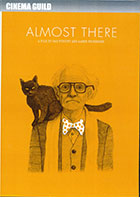
Almost There 2015
Distributed by Cinema Guild, 115 West 30th Street, Suite 800, New York, NY 10001; 212-685-6242
Produced by Dan Rybicky and Aaron Wickenden
Directed by Dan Rybicky and Aaron Wickenden
DVD, color, 85 min.
College - General Adult
Aging, Art, Art History, Documentaries, Films, Humanities, Social Problems, Storytelling
Date Entered: 01/27/2017
Reviewed by Dawn K. Wing, Media Services Librarian, Suffolk County Community CollegeSometimes the line between art and life can be hard to distinguish, especially if the subject of your film is a charismatic yet cranky octogenarian living in a collapsing house. This was the case for Dan Rybicky and Aaron Wickenden, the filmmakers behind the deeply engaging and heartfelt documentary, Almost There, which recounts the personal history and creative ambitions of aging outsider artist Peter Anton. The name of the film is also the title of Peter's creative masterpiece.
What makes Almost There a refreshing documentary is the transparency between filmmaker and subject, life and art and how enmeshed those relationships can be. The film begins with Rybicky and Wickenden's concerns with Peter's health and living conditions upon entering his home. Friends of Peter are included in the film to discuss their connection to the artist, and the role they play in helping him to survive. Meanwhile, Peter believes he must suffer for his art as many have romanticized in artists like Van Gogh. However, as the film progresses, we observe how his suffering begins to take a toll on caretakers, including the filmmakers.
Rybicky daringly relates to this aspect of Peter by including in the film the story of his own brother, an artist also struggling with mental instability. The charm and appeal of Almost There is how much making the film and taking care of Peter clearly meant to the filmmakers personally, particularly for Rybiky. The great gift he gives to viewers is not just capturing the vulnerability of Peter, but also of his own. We witness Rybicky's uncensored emotional reactions during a few tense scenes with Peter and with his own family.
The filmmakers do not hide that they are championing an underdog and orchestrating artistic success for him. Nor do they shy away from a potentially damaging oversight when a past incident catches up with Peter during the making of the film. By boldly delving into this conflict through investigative interviewing with various members of Peter's community, the filmmakers go through the unsavory process of uncovering truth in an effort to restore trust and integrity in Peter. Ultimately, the film reveals how much community is an integral part of Peter's life as it is with his art. Without one or the other, perhaps, the artist would not be where he is today.
Almost There is highly recommended for art and art history courses examining ethical issues in collaborative art-making, art education and curatorship. Viewers will be in for a visual treat as the aesthetic design and editing of the film is quirky and colorful, just like its subject Peter Anton.